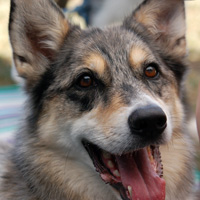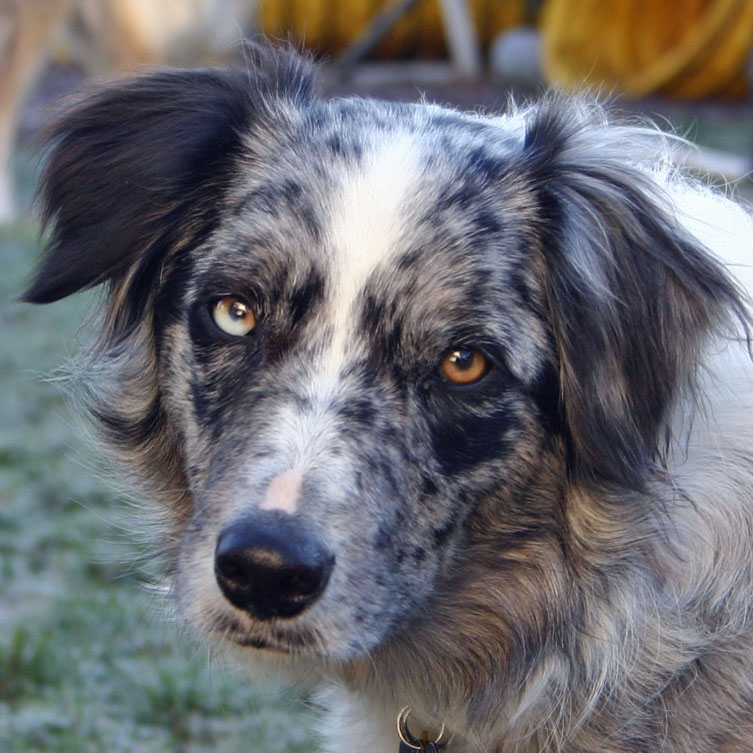Crate Training
In its most succinct definition, crate training is simply getting a dog used to a crate and, preferably, so that the dog enjoys being in the crate.
Susan Garrett is one of the preeminent agility trainers and lecturers in North America. She's extremely popular in California, although she's from Ontario (the one in Canada, not the one in southern CA).
She does crate training using Crate Games, her name for her specific, step-by-step method. Here is my interpretation of Crate Games.
NOTE: Once you start this process, dog must not leave crate for any reason until you get to the end.
GOAL: Dog must sit near the back of the crate whenever you start to open the door.
- Crack the door and feed at the top back of the crate. Repeat 5x (some dogs need more).
- Details:
- Dog in (preferably) wire crate.
- Kneel in front of crate with goodie in hand opposite the door's hinges.
- Using arm closest to hinges, open door just wide enough to shove your goodie hand in to the upper back of the crate. Allow the dog to take goodie. Remove arm and close door. (No verbal cues or praise at any time.)
- Take hand off door. Wait about 5 seconds.
NOTE: Dog must not be able to leave crate or even get a nose outside door at any time; if dog attempts to do so, immediately and calmly close door (don't slam it on his nose).
NOTE: Dog might already be thinking about sitting in the back when you put hand on door. - Dog in (preferably) wire crate.
- Open door halfway; hesitate for *half a second*. If dog doesn't try to get out, reach in, feed; close door. Repeat about 5x.
- Details:
- Repeat until dog is waiting inside rather than lunging towards door.
- Open door all the way, wait a second or two, feed in back, close door. Repeat about 5x.
- Details:
- Keep hand on door when it's open. Now you can start feeding thru the top instead of putting your arm in).
NOTE: By now, dog might be sitting as soon as you touch door. If not, try waiting, wiggling handle a bit, waiting. Feeding in back towards top should be forcing the dog into a sit. - Start adding distractions. Feed quickly after each success.
- Details:
- Stand up. If dog doesn't move, feed, close door. Open door. Wait. feed. Pick up leash. Feed. Close door. (In other words, start stringing a couple of distractions together, but reward after each one.) Drop a goodie outside the crate. If dog stays put, pick it up and feed it to him in the back.
- When you get to where you can put the dog's leash on and stand up and dog doesn't move, open door, stand on leash, give release word to let dog out of crate, wait for him to go back into crate, praise profusely.
- Details:
- Stand on side of open door facing the door (so that you and the open door form a channel back into the crate). Stand on the leash so there's just enough slack for the dog to get out of the crate.
- Give your chosen release work (e.g., "Break"). If dog doesn't come out of crate, encourage (pat legs, verbal encouragement--no more commands).
- When dog comes out of crate, ignore him. When he turns and goes back into crate, lavish him with goodies and praise.
- If dog doesn't go back in within 2 minutes, limit his choices--e.g., hold his collar so that he's facing the crate and can't move anywhere except into the crate; as soon as he steps in that direction, release him so he can go in. Praise enthusiastically & give goodies.
- Stand on side of open door facing the door (so that you and the open door form a channel back into the crate). Stand on the leash so there's just enough slack for the dog to get out of the crate.
- Repeat until dog is coming out on release word and immediately going back in.
- When dog gets to where he won't come out, add something to make him come out, e.g., a low-value goodie, then wait for him to go back in, etc.
Boost's training
I used basically this method when I first got Boost; worked great. The first time I released her from the crate, it must've taken 5 minutes before she went back in. I had to have her in one position, keeping her from sitting, for about 5 minutes before she went back in, but then after that it was a cake-walk.
However, over time I let up on the getting-excited-about-going-back-in bit, so although she'll go in on her own often, and she (usually) goes in on command, the "usually" is not ideal, and she doesn't drive into it like it's the best place in the world, which is what you want.
So I did Boost at a Susan Garrett seminar yesterday from scratch. First, she's so good about sitting when I open the door and waiting for the release that she wouldn't stretch enough to take the goodie out of my hand, even though it was hot dogs, which she hardly ever gets. Eventually she did, but that got us off to a slow start.
The middle part of the process went pretty quickly, because she already knows the routine. But when we got to where she came out of the crate, she didn't go back in! She looked around at the whole world at the end of her short leash, never even looked at the crate entrance. When I finally took her collar and held her in place, she immediately plonked into a sit and just sat there for almost another 2 minutes; just when I was ready to start forcing her into a stand, she finally got up and went in.
After that, she was fine, bouncing in and out for me.
Tika's training
Soooo--since I didn't do this with Tika when I first got her (basically used goodies tossed into the back of the crate), and since she's so wired that she has a horrible time staying in the crate when the door is opened, I decided to start from scratch with her today. Wow, what an adventure.Understand that she has a horrible time with self-control. Can't stay lying down or sitting down for more than a couple of seconds if there's food involved. All my other dogs (Boost included) learned very quickly that, if the crate door is open and I have food of any kind, they get some if they're lying down. (Same thing with popcorn while watching TV.) Tika slams into a down, but leaps to her feet if nothing is forthcoming within a second or two, then she watches me toss food to the other dogs, salivating--then eventually slams herself into a down, then leaps to her feet to lunge forward and grab the food when I toss it her way, then stands there, quivering, moving front feet in and out of the crate, watching as I give the other dogs food... you maybe get the picture. A litttttle overstimulated.
So, today, here's how we went:
- Crack door, 5 treats in the back. Dog might already start getting idea that goodies will be coming into the back.
- Details:
- Getting the first five treats into the back of the crate were easy, because she simply followed my hand to the back of the crate and took the goodie, being forced into a sit, although she tried extremely hard not to have to actually put her butt down.
- Still, each time, she frantically followed my hand as I removed it from the crate.
- Then she started nosing at the door, not picking up the clue about the back of the crate.
From there to where I was opening the door all the way?-- I must've gone through more than a hundred repetitions with her before I could start leaving the door open, and she's still not sitting reliably when I put my hand on the door--she tends to lie down instead, and it's funny how we got there. - Open door partway, hesitate half a second, feed if dog doesn't try to go through door. Repeat 5x.
- Details:
- She's in some ways a fairly "operant" dog--in Susan's terms, that means that when I get the clicker and goodies out, she starts offering behaviors. So that's what she started doing, spinning and backing up and lying down and bowing and doing nose touches to various parts of the door (not the floor--hmmmm), anything at all, desperate to get a goodie.
- As soon as her nose was away from the door, I'd try to open it partially for half a second; most of the time, she'd lunge forward to shove her nose out the door.
- But when she'd actually hesitate before doing that, I'd feed her immediately in the back of the crate and close the door. Then she'd start nosing and pushing at the door...
- and on and on, maybe 40 or 50 times.
- She's in some ways a fairly "operant" dog--in Susan's terms, that means that when I get the clicker and goodies out, she starts offering behaviors. So that's what she started doing, spinning and backing up and lying down and bowing and doing nose touches to various parts of the door (not the floor--hmmmm), anything at all, desperate to get a goodie.
- Open the door for half a second before feeding, if dog doesn't move towards door.
- Details:
- took forever--as soon as I put my hand on the door, she'd start nosing at it.
- Or, when she finally stopped nosing at it, the second the door opened, she'd start to shove her nose out the door and I'd close it again.
- It took a dozen or more tries each time before I'd be able to get the door open.
I tried to be excruciatingly consistent--if her nose came thru the door even half an inch, I closed it again, because I *know* she'll be one, if given a millimeter, to take a mile. - But the most likely time for her to be not pushing at the door was when she was lying down, so after a few times of me opening the door right after she slammed into a down, she decided that's the position I wanted. It didn't matter that she had to sit up and swing around to the back of the crate to get her goodie every time--she'd immediately swing her nose right back to the front of the crate after I gave her the goodie.
- I gave her dozens in the back of the crate--swing to the front, swing back to get the goodie, swing to the front, swing back to get the goodie, swing front, swing to the back for the goodie, lie down, get up and swing to the back, lie down, get up and swing to the back...
And I've always said she was a quick learner! I didn't time it, but I think it was half an hour from when we started (I was getting a little tired!) before we finally got to the part where she'd be sitting far enough back from the door that I could open the door and wait, then feed.
- took forever--as soon as I put my hand on the door, she'd start nosing at it.
- Add distractions.
- Details: But from there it seemed to go pretty quickly to where I could drop a goodie, put on her leash, all that stuff, and she stayed away from the door (that's a miracle with her!).
- Stand on leash, release dog, wait for her to go back in.
- Details:
- Here's another funny part--remember how long it took Boost to go back into the crate? With Tika, I opened the door and released her--she came out, barely slowed down--then spun and dashed right back in!
Susan had made the point that giving hundreds of goodies for desired behavior before ever allowing a dog the choice of an unwanted behavior almost guaranteed that they'd try to do the right thing or return to that environment--and, sure enough, Tika sure associated the crate with hot dogs! So the next couple of times I had to actually encourage her to come out before she then spun and went back in.
- Here's another funny part--remember how long it took Boost to go back into the crate? With Tika, I opened the door and released her--she came out, barely slowed down--then spun and dashed right back in!
She was just so funny, swinging all the way to the back of the crate, then all the way to the front, every five seconds as I reopened the door, never deciding to stay towards the back! This is a dog who doesn't really care about the reward cost (is that the term susan used? I keep thinking "return on investment"!), she has so much energy to burn! (The theory is that the dog will quickly figure out that, to get the goodie, they have to be sitting in the back of the crate, and the "reward cost" of standing up, swinging to the back, swinging to the front, etc. each time is too high and will do the smart thing and just wait there for it. Ha!) Complete list of labels






2 Comments:
Am thinking of buying Crate Games for my two boys. Googled it and your GREAT and informative post came up. Sounds like a worthwhile investment and fun thing to work on during our snowy winter (I am in New England).
Glad you found this useful!
Post a Comment
Links to this post:
Create a Link
<< Home